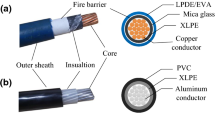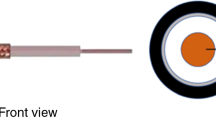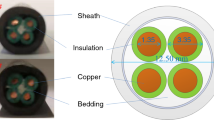Abstract
The combustion, smoke emission, and toxic gas emission characteristics of four types of flame-retardant cables and two types of fiber-optic cables were investigated. The thickness, flame retardancy, and volatile components of the polymeric materials constituting the cables mainly influenced their released heat and smoke emissions. The volatile components increased the magnitude of the first peak of heat release and shortened the interval between the time to ignition and first heat release. The thickness and flame retardancy caused the formation of a char layer, which caused the peak values associated with the secondary heat release and smoke production. Fiber-optic cables with zero halogens exhibited a lower flame retardancy than that of the flame-retardant cables as they were completely pyrolyzed early but emited small amounts of smoke and toxic gases. By considering trade-off between flame retardancy and toxicity, the improvements in fire protection strategies and amendment of cable design criteria are recommended.
Similar content being viewed by others
Abbreviations
- NPP :
-
Nuclear power plant
- FR :
-
Flame-retardant
- CCT :
-
Cone calorimeter test
- TTI :
-
Time to ignition
- HRR :
-
Heat release rate
- THR :
-
Total heat release
- SPR :
-
Smoke production rate
- TSP :
-
Total amount of smoke production
- FR-C :
-
Flame-retardant class 1E
- FR-NC :
-
Flame-retardant non-class 1E
- ZH-OF :
-
Zero halogen optic fiber
- TI :
-
Toxicity index
- PHRR :
-
Peak of HRR
- tPHRR :
-
Time to PHRR
- Δ t P-I :
-
Time difference between TTI and first tPHRR
- PSPR :
-
Peak of SPR
- tPSPR :
-
Time to PSPR
References
G. Vinod et al., Insights from fire PSA for enhancing NPP safety, Nucl. Eng. Des., 238 (9) (2008) 2359–2368.
M. H. Jee, C. K. Moon and H. T. Kim, Performance-based fire fighting strategies for confined fire zones in nuclear power plants, Prog. Nucl. Energy, 62 (2013) 16–25.
T. Seguchi et al., Degradation of cable insulation material by accelerated thermal radiation combined ageing, IEEE Trans. Dielectr. Electr. Insul., 22 (6) (2015) 3197–3206.
T. Gong, Q. Xie and X. Huang, Fire behaviors of flame-retardant cables, part I: decomposition, swelling and spontaneous ignition, Fire Saf. J., 95 (2018) 113–121.
O. Keski-Rahkonen and J. Mangs, Electrical ignition sources in nuclear power plants: statistical, modelling and experimental studies, Nucl. Eng. Des., 213 (2–3) (2002) 209–221.
IEEE 383-1974, IEEE Standard for Type Test of Class 1E Electric Cables, Field Splices, and Connections for Nuclear Power Generating Stations, IEEE Standard Association (1974).
J. M. Daly, IEEE 1202 flame testing of cables for use in cable tray, Conference Record of 1991 Annual Pulp and Paper Industry Technical Conference (1991) 100–104.
T. V. Santhosh et al., An approach for reliability prediction of instrumentation and control cables by artificial neural networks and Weibull theory for probabilistic safety assessment of NPPs, Reliab. Eng. Syst. Saf., 170 (2018) 31–44.
M. H. Kim et al., Influence of thermal aging on the combustion characteristics of cables in nuclear power plants, Energies, 14 (7) (2021) 2003.
M. A. Barnes, A. F. Matheson and T. J. O. Neill, A comparative study of the fire performance of halogenated and non-halogenated materials for cable applications part 1 tests on cables, Fire and Materials, 20 (1) (1996) 17–37.
J. Kaczorek-Chrobak and K. Fangrat, Combustible material content vs fire properties of electric cables, Energies, 13 (23) (2020) 6172.
J. Kaczorek-Chrobak and K. Fangrat, Influence of constructional-material parameters on the fire properties of electric cables, Energies, 12 (23) (2019) 4569.
C. Magalie et al., Fire behaviour of electrical cables in cone calorimeter: influence of cables structure and layout, Fire Saf. J., 99 (2018) 12–21.
H. C. Wu et al., Case study on prevention of fire hazards in coating epoxy-based FRP work with illumination, J. Loss Prev. Process Ind., 23 (2) (2010) 346–350.
X. Huang et al., Burning behavior of cable tray located on a wall with different cable arrangements, Fire Mater, 43 (1) (2019) 64–73.
L. Rigollet et al., OECD/NEA PRISME Project Application Report, Nuclear Safety NEA/CSNI/R(2012)14, Organization for Economic Co-operation and Development (2012).
L. Audouin et al., OECD PRISME project: fires in confined and ventilated nuclear-type multi-compartments — overview and main experimental results, Fire Saf. J., 62 (PART B) (2013) 80–101.
X. Huang et al., Improved model for estimating sidewall effect on the fire heat release rate of horizontal cable tray, Process Saf. Environ. Prot., 149 (2021) 831–838.
ISO 5660-1:2015, Reaction-to-Fire Tests — Heat Release, Smoke Production and Mass Loss Rate — Part 1: Heat Release Rate (Cone Calorimeter Method) and Smoke Production Rate (Dynamic Measurement), International Organization for Standardization (2015).
IEC 60331:2018, Tests for Electric Cables under Fire Conditions — Circuit Integrity, International Electrotechnical Commission (2018).
UL 1685, UL Standard for Safety Vertical-Tray Fire-Propagation and Smoke-Release Test for Electrical and Optical-Fiber Cables, 3rd Edition, Underwriters Laboratories, Inc., North-brook (2007).
ISO 5659-2:2017, Plastics — Smoke Generation — Part 2: Determination of Optical Density by a Single-Chamber Test, International Organization for Standardization (2017).
IEC TS 61034-2:1991/AMD1:1993, Amendment 1 — Measurement of Smoke Density of Electric Cables Burning under Defined Conditions — Part 2: Test Procedure and Requirements, International Electrotechnical Commission (1993).
NES 713: Issue 3, Determination of the Toxicity Index of the Products of Combustion from Small Specimens of Materials, Naval Engineering Standards, UK Ministry of Defence (2013).
ISO 1182:2020, Reaction to Fire Tests for Products — Non-Combustibility Test, International Organization for Standardization (2020).
ISO 19702:2015, Guidance for Sampling and Analysis of Toxic Gases and Vapours in Fire Effluents Using Fourier Transform Infrared (FTIR) Spectroscopy, International Organization for Standardization (2015).
H. H. Liang and M. C. Ho, Toxicity characteristics of commercially manufactured insulation materials for building applications in Taiwan, Constr. Build. Mater, 21 (6) (2007) 1254–1261.
H. J. Seo et al., Investigation into the toxicity of combustion products for CR/EPR cables based on aging period, J. Mech. Sci. Technol., 34 (4) (2020) 1785–1794.
L. Ahmed et al., Fire reaction properties of polystyrene-based nanocomposites using nanosilica and nanoclay as additives in cone calorimeter test, J. Therm. Anal. Calorim., 132 (3) (2018) 1853–1865.
A. A. Hanna et al., Studies on the flammability of polypropylene/ammonium polyphosphate and montmorillonite by using the cone calorimeter test, Open Chem., 16 (1) (2018) 108–115.
X. Chen et al., TG — FTIR characterization of volatile compounds from flame retardant polyurethane foams materials, J. Anal. Appl. Pyrolysis, 100 (2013) 186–191.
B. Schartel and T. R. Hull, Development of fire-retarded materials-interpretation of cone calorimeter data, Fire Mater, 31 (5) (2007) 327–354.
C. Kaynak and E. Ibibikcan, Contribution of nanoclays to the flame retardancy of polyethylene-based cable insulation materials with aluminum hydroxide and zinc borate, J. Fire Sci., 32 (2) (2014) 121–144.
H. J. Kruger et al., Cone calorimeter study of polyethylene flame retarded with expandable graphite and intumescent fire-retardant additives, J. Fire Sci., 32 (6) (2014) 498–517.
X. Zheng and P. A. Cusack, Tin-containing layered double hydroxides: synthesis and application in poly (vinyl chloride) cable formulations, Fire Mater, 37 (1) (2013) 35–45.
G. Gallina et al., Application of cone calorimeter for the assessment of class of flame retardants for polypropylene, Fire Mater, 22 (1) (1998) 15–18.
T. R. Hull, A. Witkowski and L. Hollingbery, Fire retardant action of mineral fillers, Polym. Degrad. Stab., 96 (8) (2011) 1462–1469.
B. S. Zhang et al., Effects of insulating material ageing on ignition time and heat release rate of the flame retardant cables, Procedia Eng., 211 (2018) 972–978.
R. Chen et al., Correlation analysis of heat flux and cone calorimeter test data of commercial flame-retardant ethylenepropylene-diene monomer (EPDM) rubber, J. Therm. Anal. Calorim., 123 (1) (2016) 545–556.
O. Grexa and H. Lübke, Flammability parameters of wood tested on a cone calorimeter, Polym. Degrad. Stab., 74 (3) (2001) 427–432.
B. H. Lee et al., Evaluating the flammability of wood-based panels and gypsum particleboard using a cone calorimeter, Constr. Build. Mater, 25 (7) (2011) 3044–3050.
A. P. Mouritz, Z. Mathys and A. G. Gibson, Heat release of polymer composites in fire, Compos. Part A Appl. Sci. Manuf., 37 (7) (2006) 1040–1054.
E. Jin and Y. J. Chung, Fire risk assessment of cypress wood coated with metal oxide and metal silicate flame retardant using cone calorimeter, J. Fire Sci., 38 (6) (2020) 504–521.
B. Li, Influence of polymer additives on thermal decomposition and smoke emission of poly (vinyl chloride), Polym. Degrad. Stab., 82 (3) (2003) 467–476.
T. R. Hull et al., Factors affecting the combustion toxicity of polymeric materials, Polym. Degrad. Stab., 92 (12) (2007) 2239–2246.
A. Schnipper and L. Smith-hansen, Reduced combustion efficiency of chlorinated compounds, resulting in higher yields of carbon monoxide, Fire Mater, 19 (1995) 61–64.
S. A. Molyneux, A. A. Stec and T. R. Hull, The correlation between carbon monoxide and hydrogen cyanide in fire effluentsof flame retarded polymers, Fire Saf. Sci., 11 (2014) 389–403.
B. H. Hun et al., A study on the fire characterization of foam block using cone-calorimeter and FTIR, Fire Sci. Eng., 31 (6) (2017) 23–32.
S. R. Turns, An Introduction to Combustion Concepts and Applications, 3rd Edition, Mc Graw Hill (2012) 573–574.
E. D. Weil, S. Levchik and P. Moy, Flame and smoke retardants in vinyl chloride polymers — commercial usage and current developments, J. Fire Sci., 24 (3) (2006) 211–236.
S. V. Levchik and E. D. Weil, Combustion and fire retardancy of aliphatic nylons, Polym. Int., 49 (10) (2000) 1033–1073.
A. Bissonier et al., An experimental investigation of the combustion of technical tetrachlorobenzene in a laboratory scale incinerator, Combust. Flame, 129 (3) (2002) 239–252.
Y. Chi et al., Influence of chlorine on methane oxidation, J. Environ. Sci., 21 (9) (2009) 1315–1320.
H. Y. Jang and C. H. Hwang, Methodology for DB construction of input parameters in FDS-based prediction models of smoke detector, J. Mech. Sci. Technol., 34 (12) (2020) 5327–5337.
Acknowledgments
This work was supported by the Nuclear Safety Research Program through the Korea Foundation of Nuclear Safety (KOFONS) using financial resources granted by the Nuclear Safety and Security Commission (NSSC) of the Republic of Korea [grant number 1705002]. This work was also supported by an Incheon National University Research Grant (2022).
Author information
Authors and Affiliations
Corresponding author
Additional information
Min Chul Lee received his M.S. in Mechanical Engineering from Korea Advanced Institute of Science and Technology in 2003 and his Ph.D. in Mechanical and Aeronautical Engineering from Seoul National University in 2014. He is currently a Professor at Incheon National University and Head of the Combustion and Fire Engineering Laboratory. He has worked on a number of joint government and industry projects to develop the next generation of low-emission, fuel-flexible gas turbine combustors and fire safety technologies.
Min Ho Kim received his M.S. in Safety Engineering from Incheon National University. His research interest is combustion and fire safety engineering.
Seok Hui Lee performed her M.S. course in Safety Engineering from Incheon University. Her research interest is fire safety engineering and fire dynamics simulator.
Seung Yeon Jeong performed her M.S. course in Safety Engineering from Incheon National University. Her research interest is combustion and fire safety engineering and consequence analysis.
Sang Kyu Lee received his M.S. in Mechanical Engineering from Kookmin University in 1997. He is currently a Principal Researcher at KINS (Korea Institute of Nuclear Safety). He has also been an R&D project manager related to fire protection in the nuclear field.
Ju Eun Lee received her M.S. in Nuclear Engineering from Seoul National University in 2017. She is currently a Senior Researcher at KINS (Korea Institute of Nuclear Safety). She is involved in regulatory work in the field of fire protection for nuclear power plants.
Ji Hyun Kwark received his M.S. and Ph.D. in Mechanical Engineering in 1998 and 2004 from Pusan National University, respectively. He has been working for Fire Insurers Laboratories of Korea since 2004. His research interests are fire dynamics and fire protection equipments.
Rights and permissions
About this article
Cite this article
Kim, M.H., Lee, S.H., Jeong, S.Y. et al. Investigation of combustion, smoke, and toxicity characteristics of flame-retardant and fiber-optic cables used in nuclear power plants. J Mech Sci Technol 37, 987–999 (2023). https://doi.org/10.1007/s12206-023-0138-x
Received:
Revised:
Accepted:
Published:
Issue Date:
DOI: https://doi.org/10.1007/s12206-023-0138-x




